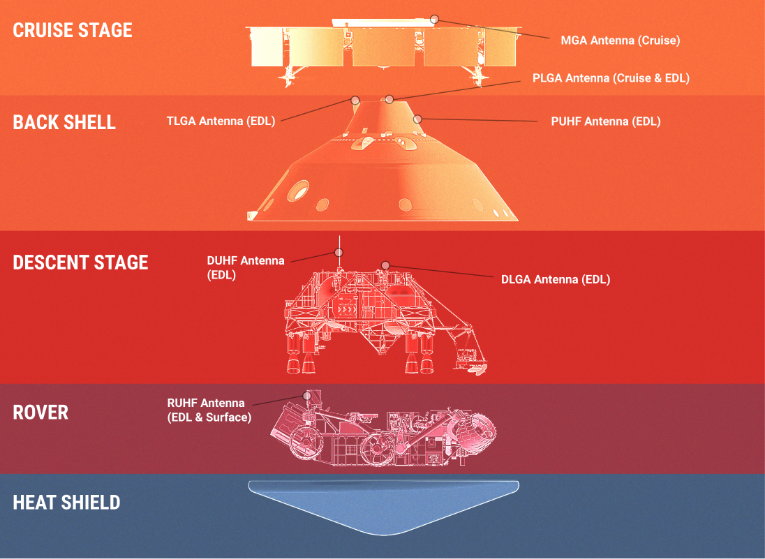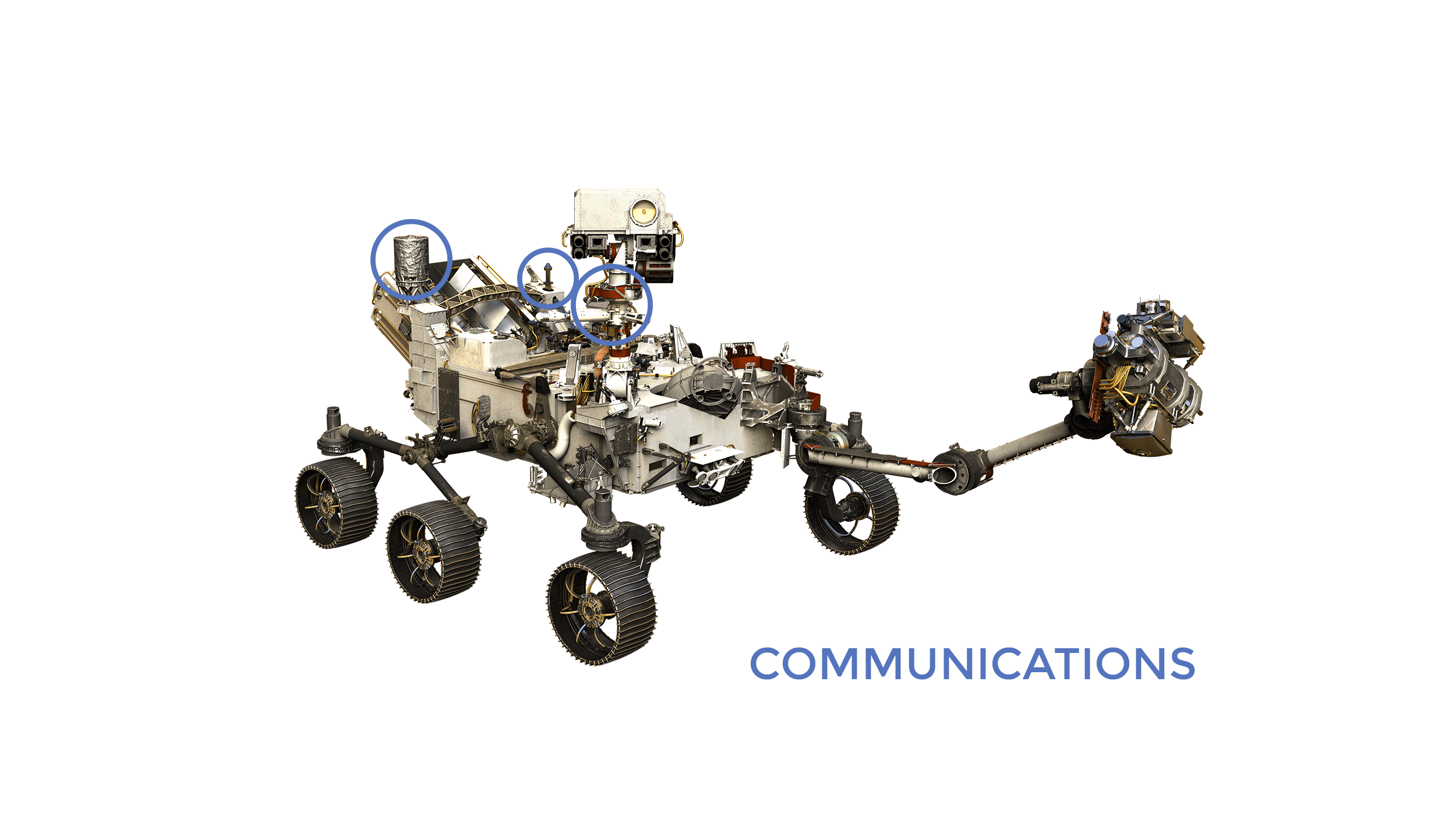Telecommunications:
How Perseverance Talks to Earth
Cruise
 Image credit: NASA/JPL-Caltech | + View Larger Image
Image credit: NASA/JPL-Caltech | + View Larger Image
For the first two months of the journey to Mars, the Mars 2020 spacecraft communicates using a low-gain antenna on the aeroshell’s parachute cone, which is exposed through the center of the cruise stage.
As the spacecraft gets farther from Earth, a stronger, medium-gain antenna located on the cruise stage takes over. This antenna provides higher data rates but requires more accurate pointing toward Deep Space Network dishes on Earth.
Landing
During landing, the spacecraft switches between several antennas. Some use ultrahigh frequency (UHF) transmission, communicating with orbiting spacecraft, like the Mars Reconnaissance Orbiter (MRO), which then relay the information back to Earth. Other antennas use more powerful X-band transmissions, talking directly to Earth with simple tones that provide basic, but limited, spacecraft health and status.
X-band
EDL communications begin with the same low-gain antenna – located on the aeroshell’s parachute cone – used at the start of the cruise phase. As the spacecraft performs banking maneuvers during its guided entry into the Martian atmosphere, it shifts to a tilted low-gain antenna on the spacecraft’s back shell. After separation from the back shell, a low-gain antenna on the powered descent stage takes over. NASA’s Deep Space Network sites located in Goldstone, California, and Madrid, Spain, will be listening for these X-band signals until Perseverance loses its direct line of sight back to Earth.
UHF
A UHF antenna mounted on the back shell starts transmitting during cruise stage separation. It continues transmitting until the back shell separates from the powered descent stage, at which point a UHF antenna on the descent stage will take over. For the rover’s final descent to the surface, it will use its cylindrical UHF low-gain antenna. Green Bank Observatory in Green Bank, West Virginia, and the Effelsberg Observatory in Germany will be listening for a dial-tone-like UHF signal called a carrier signal until Perseverance loses its direct line of sight back to Earth.
Perseverance will also use the UHF antennas to communicate detailed information during landing by transmitting data to MRO and the Mars Atmosphere Volatile EvolutioN (MAVEN) spacecraft. MRO is expected to relay EDL data to Earth in near-real-time, while MAVEN is expected to return its data within hours after landing.
MRO launched more than 15 years ago without this near-real-time relay capability. Real-time relay is often referred to as a “bent pipe” transmission. In the past year, a near-real-time relay capability, called “pseudo-bent pipe,” has been added to the veteran orbiter so it can send telemetry (detailed engineering data) to Earth throughout landing in 5-second packets, with about a 16-second latency. This required updates to MRO’s software as well as to ground data systems on Earth. These updates, combined with special maneuvers to point the spacecraft’s antenna to Deep Space Network dishes, ensure consistent data flow from Mars to Earth. Along with the near-real-time transmission, the data is recorded by MRO for later playback, which is scheduled to be transmitted to Earth several minutes after landing.
MAVEN will provide a recording of this landing data in a less processed file format. MAVEN is scheduled to transmit its data several hours after touchdown and its data also takes more time to process once it is on the ground. More detail on the transmission time table is available in the Confirmation of Landing Milestones section.
Surface
 Image credit: NASA/JPL-Caltech | Full image and caption
Image credit: NASA/JPL-Caltech | Full image and caption
Once Perseverance is wheels-down on Mars, it will begin communicating using antennas on its deck. Communication will resume through the cylindrical, paint-can-shaped UHF low-gain antenna at the back of the rover. During surface operations, 99.9% of science data is communicated through this antenna to passing orbiters, including MAVEN and MRO, as well as ESA’s (European Space Agency’s) Trace Gas Orbiter.
Commands sent from Earth will routinely be received by Perseverance’s X-band high-gain antenna, the rotatable hexagonal paddle toward the back of the rover. While the antenna is also capable of transmitting data back to Earth, it is limited.
If the views and distance to the Earth are favorable, Perseverance can also use an X-band low-gain antenna (a chess-piece-shaped antenna behind the high-gain antenna).
More on Spacecraft
-

Perseverance Rover
Learn more about this part of the spacecraft
-

Getting to Mars
Learn more about this part of the spacecraft
-

Power
Learn more about this part of the spacecraft
-

Telecommunications
Learn more about this part of the spacecraft
-

Biological Cleanliness
Learn more about this part of the mission
-

Experimental Technologies
Learn more about these technologies



